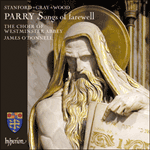Alan Gray, Stanford’s successor as organist of Trinity College, Cambridge, was a lawyer by training, but chose to pursue music after his studies with Edwin G Monk in York. As an undergraduate at Trinity College, Gray became known to Stanford, and gave occasional organ recitals there. After a period as director of music at Wellington College, he took up his appointment as organist of Trinity in January 1893—a position he held until 1930. Gray inherited a decline in the fortunes of the Trinity choir. In 1896 the choir school was abolished, and the boys were thence educated at the local Perse Grammar School in Cambridge. With less control over the interaction of their education, he found it difficult to organize rehearsals and voice-training to the same extent that Stanford had enjoyed. Much of Gray’s church music has suffered neglect. The First World War affected him deeply and he lost two of his three sons late in the conflict, their memory commemorated in his best-known anthem
What are these that glow from afar?. His settings of Rupert Brooke, in his cycle of partsongs entitled
1914, are also very moving, as is the orchestral
Elegy of 1915, played in memory of W C Denis Browne who died in the Dardanelles. His most enduring work for the Anglican liturgy is his a cappella
Magnificat and Nunc dimittis in F minor for double choir, which was published in 1912. Evincing some robust handling of well-established double-choir techniques—eight-part counterpoint, antiphony, imitation—there are also some attractive Romantic touches in Gray’s adaptation of sonata form, notably the ‘genuflection’ (‘holy is his name’) in E flat which prepares the way for the second subject in A flat (‘And his mercy is on them that fear him’). This material later returns in F major (‘As he promised to our forefathers’) before the Gloria establishes the darker hue of F minor. The more penitential
Nunc dimittis sets out more prayerfully in F minor, but its optimistic message (‘to be a light to lighten the Gentiles’) drives the music forward to A flat major before the Gloria, somewhat modified, once again brings the movement to its more familiar F minor conclusion.
from notes by Jeremy Dibble © 2020


 Parry: Songs of farewell & works by Stanford, Gray & Wood
Parry: Songs of farewell & works by Stanford, Gray & Wood
